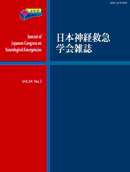Current issue
Displaying 1-9 of 9 articles from this issue
- |<
- <
- 1
- >
- >|
Review Article
-
2016 Volume 28 Issue 3 Pages 1-5
Published: June 11, 2016
Released on J-STAGE: September 01, 2016
Download PDF (736K)
Original Article
-
2016 Volume 28 Issue 3 Pages 6-11
Published: June 11, 2016
Released on J-STAGE: September 01, 2016
Download PDF (798K) -
2016 Volume 28 Issue 3 Pages 12-16
Published: June 11, 2016
Released on J-STAGE: September 01, 2016
Download PDF (570K) -
2016 Volume 28 Issue 3 Pages 17-20
Published: June 11, 2016
Released on J-STAGE: September 01, 2016
Download PDF (345K)
Case Report
-
2016 Volume 28 Issue 3 Pages 21-25
Published: June 11, 2016
Released on J-STAGE: September 01, 2016
Download PDF (646K) -
2016 Volume 28 Issue 3 Pages 26-29
Published: June 11, 2016
Released on J-STAGE: September 01, 2016
Download PDF (644K) -
2016 Volume 28 Issue 3 Pages 30-34
Published: June 11, 2016
Released on J-STAGE: September 01, 2016
Download PDF (611K) -
2016 Volume 28 Issue 3 Pages 35-39
Published: June 11, 2016
Released on J-STAGE: September 01, 2016
Download PDF (787K)
-
2016 Volume 28 Issue 3 Pages 40-43
Published: June 11, 2016
Released on J-STAGE: September 01, 2016
Download PDF (523K)
- |<
- <
- 1
- >
- >|
